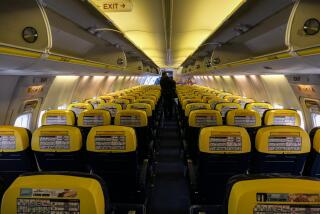Car Seats Don’t Earn Their Wings
What’s a parent to do? For years, we’ve been told that the safest way to fly with small children is to strap them into car seats. Now the results of government crash tests raise serious questions about that advice.
The Federal Aviation Administration recently tested various types of safety seats to determine how well they protected children from head injuries in hazardous situations, such as heavy turbulence or a crash landing. The agency found that rear-facing seats, the kind used for infants weighing less than 20 pounds, protect children from head injuries. That’s good news.
But the agency also found that forward-facing seats--the sort used for children weighing between 20 and 40 pounds--may not prevent serious head injury. What makes the finding even more troubling is that the agency found that aircraft lap belts don’t adequately protect toddlers, either.
The agency said that no matter how it was restrained, its toddler-size crash dummy suffered worse head injuries than an adult dummy wearing a lap belt.
The test results indicate serious deficiencies in existing standards for safety seats on aircraft. All seats tested met government standards, the agency said.
“The public may be expecting a level of protection that isn’t there,” said Van Gowty, an FAA engineer involved in the tests.
The Air Transport Assn., the industry group representing the airlines, said it was studying the report. Representatives of child safety seat makers were either unavailable or had no comment.
Gowty said most forward-facing safety seats flunked the tests because they are incompatible with aircraft lap belts. Safety seats are secured in airliner seats by the lap belt. The child is held in the safety seat with a separate shoulder harness and hip restraint.
Lap belts on aircraft do not keep the safety seats stationary, Gowty said. Under hazardous conditions, the safety seat may lunge forward, striking the back of the seat in front of it. A child in that situation is likely to suffer serious head injury.
Toddlers wearing aircraft lap belts are also at risk because heavy turbulence may cause them to bend at the waist and hit their heads on the bottom of their seats, Gowty said.
Two of eight forward-facing safety seats passed the crash test, the report shows. Gowty said those seats had a better fit with the aircraft lap belt. The seats that protected against serious head injury were the Century 2000 and the Evenflo Onestep 402, a discontinued model.
The seats that did not prevent serious head injury were Kolcraft Dial-a-Fit II, Fisher-Price Car Seat, Century 300 STE, Evenflo 7, Aviation Furnishings Carechair 2040-1 and Britax, a seat used in Britain.
The results are bound to revive a longstanding controversy over the use of safety seats on aircraft.
Federal aviation regulations permit children 2 and younger to travel on a parent’s lap for free. But child safety advocates have long urged parents to buy a ticket for the child and use a car seat. They say it is difficult, if not impossible, for a parent to hold a child during severe turbulence or a crash. They say the car seat is needed because seat belts on aircraft cannot secure an infant.
For many years, airlines were reluctant to let parents use safety seats. They said the seats were bulky and blocked aisles, creating a possible safety hazard. But the industry changed its position after a child traveling on his mother’s lap was killed with 111 other people in a United Airlines crash in Sioux City, Iowa, in 1989.
In that accident, the force of the crash swept the child from his mother and hurled him toward the rear of the plane. The child’s mother was among the survivors.
Stephanie Tombrello, executive director of Los Angeles-based Safety Belt Safe U.S.A., says the FAA tests show the agency should require that parents use rear-facing car seats for infants. The agency and the airline industry have resisted such a requirement as too costly for parents who might have to buy tickets and airlines that might need to provide safety seats. The FAA has said the expense wasn’t justified compared to the few lives that would be saved.
The FAA now says it is studying the issue and plans to provide a report to Congress by spring on whether child restraints should be required. In the meantime, the agency is encouraging airlines to offer discount fares to make it less costly for parents to use safety seats for children 2 and younger. Southwest Airlines offers a 10% discount on those tickets.
The question of how to protect older toddlers is trickier. The FAA said it plans to devise new standards for safety seat testing and labeling. Safety advocates say changes are needed.
A simple solution could be at hand. The FAA found that if the aircraft lap belt was affixed to the seat back 4.5 inches above its usual location, it securely held forward-facing child safety seats. “No head contact with the forward row seat back occurred during these tests,” the report says.
From a technological standpoint, the solution is child’s play. Unlike car seat belts, lap belts in airliners snap in and out. A second snap-in location on an airliner seat would allow flight attendants to adjust the lap belt for forward-facing seats.
Of course, even such a simple solution would require a cash-strapped industry to spend money to prevent injuries that rarely occur.
“I’ve always said that technology isn’t the problem,” said safety advocate Tombrello. “The problem is people not ensuring and demanding (that) technology is used.”
Crash Tests
The Federal Aviation Administration tested eight randomly selected forward-facing child safety seats to determine whether they kept toddlers from injuring their heads on the seats in front of them during serious turbulence or crash conditions. The FAA said serious head injury occurs at a head injury computation of 1,000 or higher. The HIC is derived by measuring how fast the head accelerates.
Restraint / HIC:
Britax: 1,477
Century 300 STE: 1,440
Fisher-Price Car Seat: 1,246
Evenflo 7: 1,195
Kolcraft Dial-a-Fit II: 1,145
Aviation Furnishings Carechair 2040-1: 1,131
Century 2000: 996
* Evenflo Onestep 402: 682
* Discontinued
Source: Federal Aviation Administration
More to Read
Sign up for Essential California
The most important California stories and recommendations in your inbox every morning.
You may occasionally receive promotional content from the Los Angeles Times.










